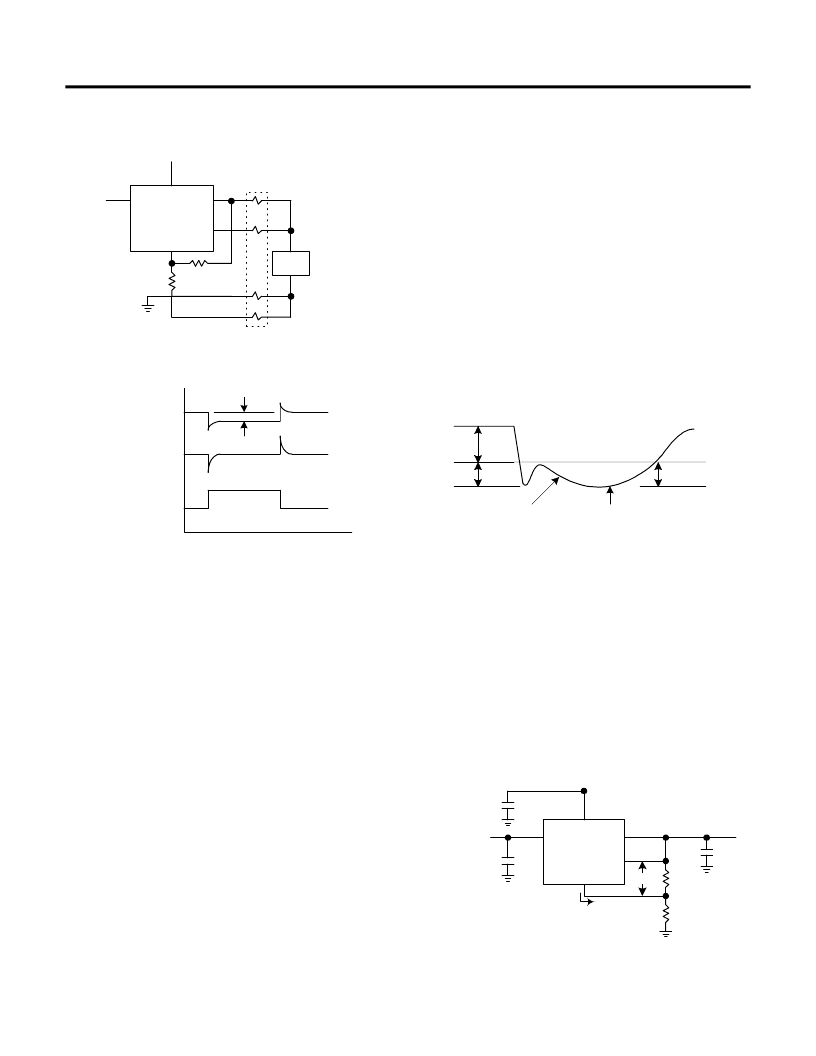- 您現(xiàn)在的位置:買(mǎi)賣(mài)IC網(wǎng) > PDF目錄382838 > AMS1510CM-33 (Advanced Monolithic Systems, Inc.) 10A LOW DROPOUT VOLTAGE REGULATORS PDF資料下載
參數(shù)資料
| 型號(hào): | AMS1510CM-33 |
| 廠(chǎng)商: | Advanced Monolithic Systems, Inc. |
| 元件分類(lèi): | 基準(zhǔn)電壓源/電流源 |
| 英文描述: | 10A LOW DROPOUT VOLTAGE REGULATORS |
| 中文描述: | 10A條低壓降穩(wěn)壓器 |
| 文件頁(yè)數(shù): | 5/9頁(yè) |
| 文件大小: | 77K |
| 代理商: | AMS1510CM-33 |

Advanced Monolithic Systems, Inc.
6680B Sierra Lane, Dublin, CA 94568 Phone (925) 556-9090 Fax (925) 556-9140
AMS1510
APPLICATION HINTS
CONTROL
POWER SENSE
AMS1510
OUTPUT
ADJ
LOAD
+
-
V
OUT
R
P
R
P
R1
R2
5V
3.3V
Figure 2. Remote Load Sensing
(
I
OUT
)(R
P
)
TIME
V
FIGURE 1
V
FIGURE 2
I
OUT
Figure 3. Remote Sensing Improves Load Regulation
Voltage drops due to R
P
are not eliminated; they will add to the
dropout voltage of the regulator regardless of whether they are
inside or outside the regulation loop. The AMS1510 can control
the voltage at the load as long as the input-output voltage is
greater than the total of the dropout voltage of the device plus the
voltage drop across R
P
.
Stability
The circuit design used in the AMS1510 series requires the use of
an output capacitor as part of the device frequency compensation.
The addition of
150
μ
F aluminum electrolytic or a 22
μ
F solid
tantalum on the output will ensure stability for all operating
conditions. For best frequency response use capacitors with an
ESR of less than 1
.
In order to meet the transient requirements of the processor larger
value capacitors are needed. Tight voltage tolerances are required
in the power supply. To limit the high frequency noise generated
by the processor high quality bypass capacitors must be used. In
order to limit parasitic inductance (ESL) and resistance (ESR) in
the capacitors to acceptable limits, multiple small ceramic
capacitors in addition to high quality solid tantalum capacitors are
required.
When the adjustment terminal is bypassed to improve the ripple
rejection, the requirement for an output capacitor increases. The
Adjust pin is brought out on the fixed voltage device specifically
to allow this capability. To ensure good transient response with
heavy load current changes capacitor values on the order of
100
μ
F are used in the output of many regulators. To further
improve stability and transient response of these devices larger
values of output capacitor can be used.
The modern processors generate large high frequency current
transients. The load current step contains higher order frequency
components than the output coupling network must handle until
the regulator throttles to the load current level. Because they
contain parasitic resistance and inductance, capacitors are not
ideal elements. These parasitic elements dominate the change in
output voltage at the beginning of a transient load step change.
The ESR of the output capacitors produces an instantaneous step
in output voltage (
V=
I)(ESR). The ESL of the output
capacitors produces a droop proportional to the rate of change of
the output current (V= L)(
I/
t). The output capacitance
produces a change in output voltage proportional to the time until
the regulator can respond (
V=
t) (
I/C). Figure 4 illustrates
these transient effects.
CAPACITANCE
EFFECTS
ESR
EFFECTS
ESL
EFFECTS
POINT AT WHICH REGULATOR
TAKES CONTROL
SLOPE, V/t =
I/C
Figure 4.
Output Voltage
The AMS1510 series develops a 1.25V reference voltage
between the Sense pin and the Adjust pin (Figure5). Placing a
resistor between these two terminals causes a constant current to
flow through R1 and down through R2 to set the overall output
voltage. In general R1 is chosen so that this current is the
specified minimum load current of 10mA.The current out of the
Adjust pin is small, typically 50
μ
A and it adds to the current
from R1. Because I
ADJ
is very small it needs to be considered
only when very precise output voltage setting is required. For
best regulation the top of the resistor divider should be connected
directly to the Sense pin.
CONTROL
POWER OUTPUT
AMS1510
SENSE
ADJ
R1
R2
V
OUT
V
REF
V
POWER
I
ADJ
50
A
+
+
+
V
CONTROL
V
OUT
= V
REF
(
1+ R2/R1)+I
ADJ
R2
Figure 5. Setting Output Voltage
相關(guān)PDF資料 |
PDF描述 |
|---|---|
| AMS1510CM-35 | 10A LOW DROPOUT VOLTAGE REGULATORS |
| AMS1510CM-50 | 10A LOW DROPOUT VOLTAGE REGULATORS |
| AMS1585 | Hex Schmitt-Triggered Inverters 14-PDIP -55 to 125 |
| AMS1585CT-33 | 4.6A LOW DROPOUT VOLTAGE REGULATOR |
| AMS1585CT-30 | 4.6A LOW DROPOUT VOLTAGE REGULATOR |
相關(guān)代理商/技術(shù)參數(shù) |
參數(shù)描述 |
|---|---|
| AMS1510CM-35 | 制造商:ADMOS 制造商全稱(chēng):ADMOS 功能描述:10A LOW DROPOUT VOLTAGE REGULATORS |
| AMS1510CM-5.0 | 制造商:ADMOS 制造商全稱(chēng):ADMOS 功能描述:10A LOW DROPOUT VOLTAGE REGULATORS |
| AMS1510CM-50 | 制造商:ADMOS 制造商全稱(chēng):ADMOS 功能描述:10A LOW DROPOUT VOLTAGE REGULATORS |
| AMS1510CT | 制造商:ADMOS 制造商全稱(chēng):ADMOS 功能描述:10A LOW DROPOUT VOLTAGE REGULATORS |
| AMS1510CT-1.5 | 制造商:ADMOS 制造商全稱(chēng):ADMOS 功能描述:10A LOW DROPOUT VOLTAGE REGULATORS |
發(fā)布緊急采購(gòu),3分鐘左右您將得到回復(fù)。